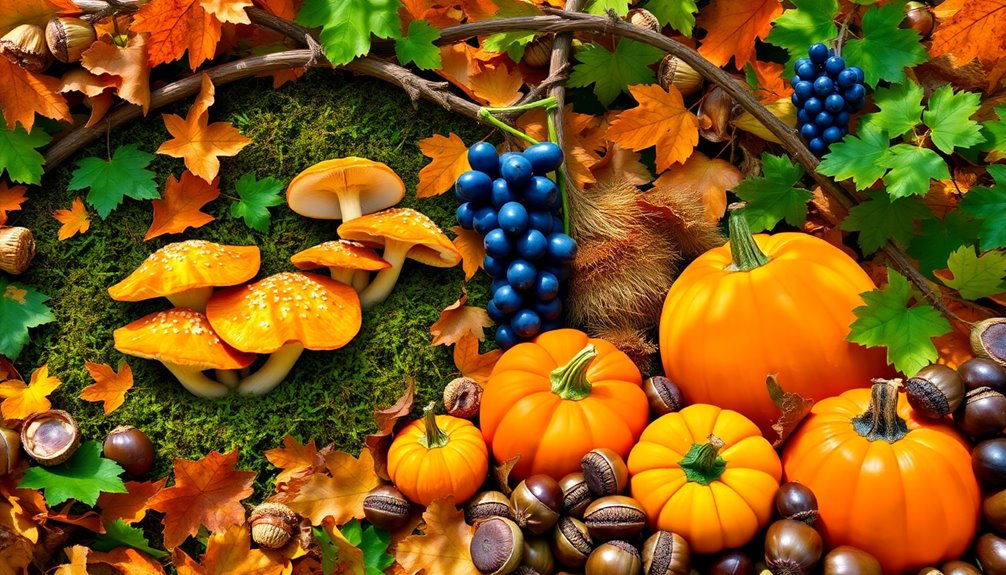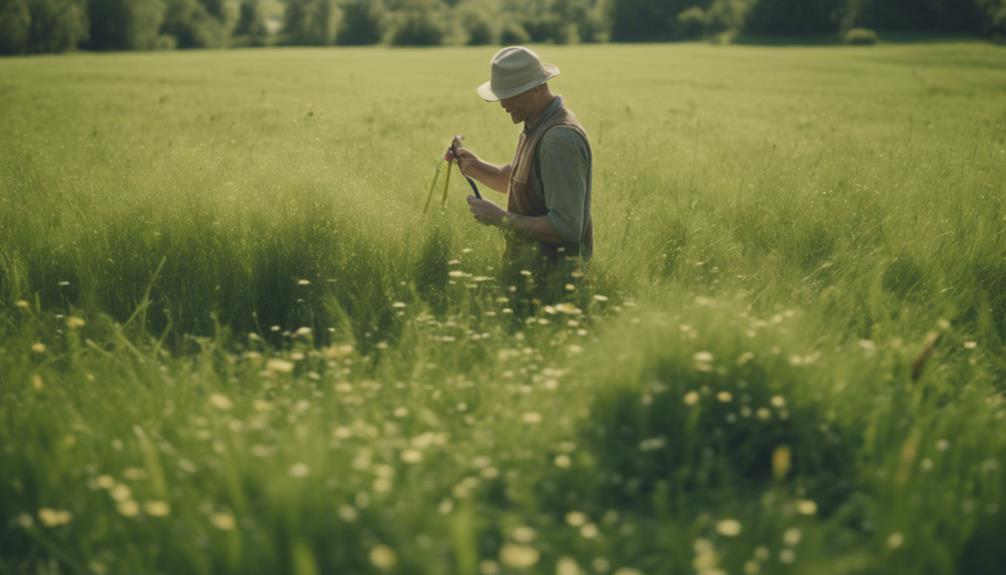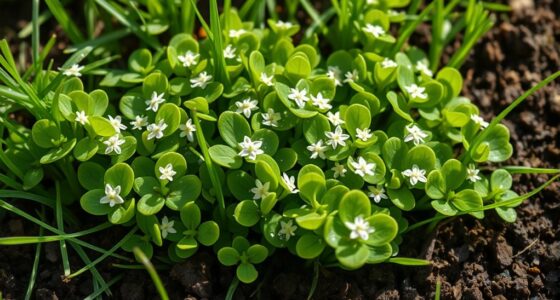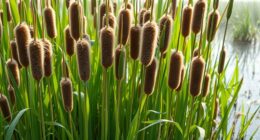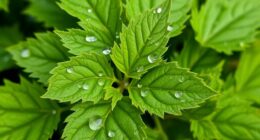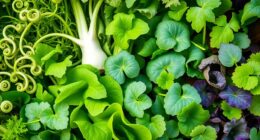In August, you can discover delicious wild treats hiding in plain sight across the UK. Look for juicy blackberries, sweet elderberries, and succulent wild raspberries, perfect for snacking or making jams. Don't forget the vibrant sea buckthorn berries, packed with vitamin C, along the coast. You can also forage unique plants like lemon balm and borage to enhance your meals. Just be sure to wash your finds thoroughly and confirm their identities to avoid toxic look-alikes. Keep exploring, and you'll uncover even more tasty treasures waiting for you this late summer!
Key Takeaways
- Late summer is ideal for foraging juicy blackberries and elderberries, perfect for jams and syrups.
- Explore woodlands for wild raspberries and bilberries, both delicious for snacking or desserts.
- Sloes ripen earlier in warm weather; use them for making Sloe Gin or infused spirits.
- Look for vibrant sea buckthorn berries, packed with vitamin C, from August to December along the coast.
- Engage in community foraging events and scavenger hunts to enhance your skills and connect with nature.
Top Edible Berries in August
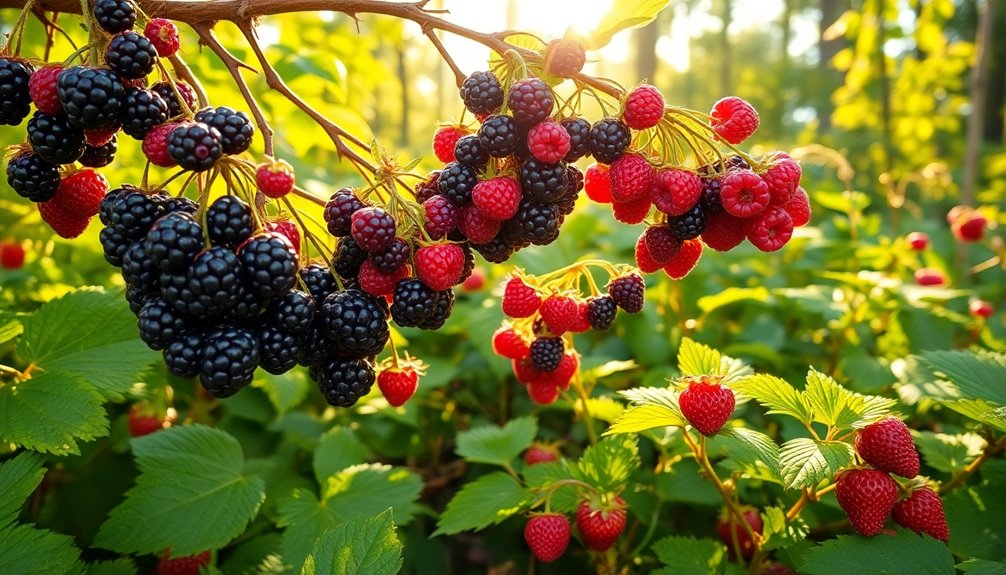
Foraging for berries in August is a delightful way to connect with nature and enjoy the season's bounty. This month is prime time for picking blackberries (Rubus fruticosus). Look for them when they're deep purple-black; they're perfect for pies, jams, and syrups. You'll find these juicy gems thriving in hedgerows and along pathways, inviting you to savor their sweet and tart flavors.
Don't forget about elderberries (Sambucus nigra), which are also ready for harvest in August. Their dark red-black clusters are easy to spot. While they're fantastic for making cordials and wines, remember to cook them before consumption, as raw elderberries can be toxic.
As you forage, keep an eye out for other berries like mulberries and sloes, although they may not be as abundant.
Mulberries (Morus nigra) can quickly stain your hands, so use them promptly or freeze them for later.
Sloes (Prunus spinosa) are best for those looking to craft Sloe Gin.
With so many options, your basket will surely overflow with nature's late summer treats!
Unique Forageable Plants
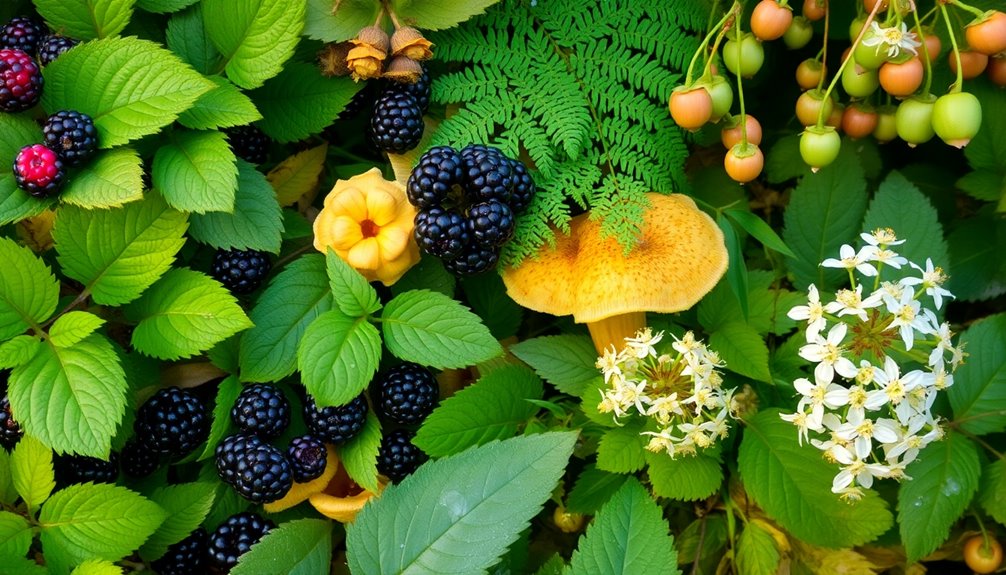
As you explore the outdoors this August, keep an eye out for unique forageable plants that can enhance your culinary adventures.
From aromatic herbs like lemon balm to vibrant borage flowers, these lesser-known treasures can add flavor and flair to your dishes.
Just remember to prioritize foraging safety to guarantee a successful and enjoyable experience.
Lesser-Known Edible Berries
When exploring the wilds of the UK in August, you'll discover a treasure trove of lesser-known edible berries that are often overlooked.
These wild native treats are perfect for your late summer foraging adventures. Here's a quick guide to get you started:
- Pheasant Berries: These transform from green to deep purple when ripe, boasting a sweet toffee-like flavor. Remember, unripe berries are bitter and inedible!
- Wild Raspberries: Found in woodlands, they're juicy and easy to pluck when ripe—a delightful snacking option.
- Mulberries: Dark and sweet, these berries can stain easily, making them best enjoyed fresh or frozen for later use.
- Bilberries: Similar to blueberries, bilberries are juicy and make a fantastic addition to desserts or a quick snack.
Don't forget about Sloe berries, primarily used for making Sloe Gin. They ripen earlier due to warmer weather, making August the perfect time to forage.
Keep your eyes peeled for these hidden gems as you wander through the UK's natural beauty!
Unique Culinary Plant Uses
Exploring the diverse world of unique culinary plants can elevate your late summer meals with fresh, vibrant flavors.
Consider incorporating lemon balm (Melissa officinalis) into your dishes; its young leaves add a delightful lemon scent to salads and pesto, while older leaves are perfect for barbecuing. Mindfulness techniques can enhance your cooking experience by encouraging you to savor the flavors and aromas of your fresh ingredients. Additionally, practicing effective relaxation techniques can help you enjoy the process of cooking and foraging more fully. Sustainable harvesting practices are also important to consider when foraging for these plants.
Borage (Borago officinalis) offers star-shaped blue flowers that are visually stunning and edible. Use its young leaves and flowers in salads, or steam the larger leaves for a nutritious side.
Don't overlook red clover (Trifolium pratense), with its sweet edible florets blooming from May to September. These florets not only enhance salads but also attract pollinators to your garden.
Oregano (Origanum vulgare) is another versatile wild plant; its hairy green leaves can spice up pizzas and sauces, and you can dry them for winter use or infuse them in vinegar.
Finally, wild rose (Rosa canina) petals are entirely edible. Use them raw in salads, steep them in tea, or turn them into sweet jams.
These unique culinary plants add excitement and flavor to your late summer menus, so don't hesitate to forage and experiment! Additionally, incorporating omega-3 content from seeds like chia can further enhance your dishes' nutritional value.
Foraging Safety Tips
Foraging unique culinary plants can be rewarding, but safety should always be your top priority. Here are some essential foraging safety tips to keep in mind:
- Confirm the identity of plants: Many edible species have toxic look-alikes, especially in the umbellifer family.
- Harvest young leaves: Older leaves of plants like Greater Plantain can be tough and less tasty.
- Avoid polluted areas: Steer clear of foraging near roads or contaminated sites to minimize the risk of toxins.
- Consult a guide for mushrooms: Many edible varieties have poisonous counterparts, so always check with a reliable source.
When you venture into the wild, remember that proper identification is vital. Masterful weaving can also enhance your foraging experience by providing you with a durable basket for your finds.
Always wash your foraged items thoroughly before consumption to remove any dirt, insects, or potential chemical residues. This guarantees your foraged food is safe to eat.
By following these guidelines, you can enjoy the delights of foraging while keeping health and safety front and center.
Happy foraging!
Coastal Foraging Opportunities
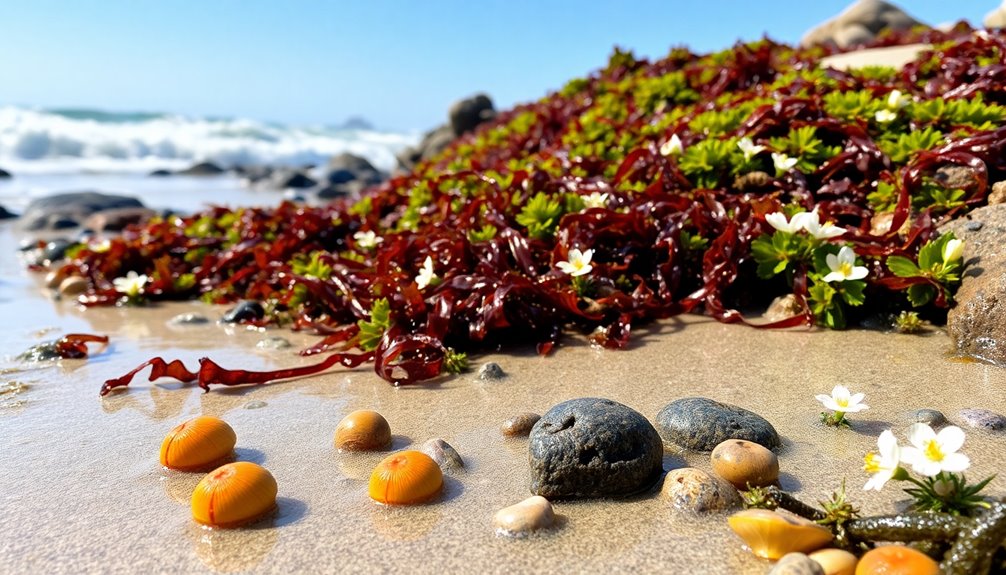
Coastal foraging opens up a world of edible treasures just waiting to be discovered. One of the highlights is the diverse range of seaweeds, packed with minerals and vitamins. You can enjoy them raw in salads or dried as a seasoning.
Don't overlook saltmarsh plants, which thrive even in harsh coastal conditions. They offer unique flavors and nutritional benefits that can enhance your meals.
From August to December, you'll find Sea Buckthorn berries ripening along the coast. These vibrant berries aren't just visually appealing; their high vitamin C content makes them a fantastic addition to your foraged finds.
As you explore coastal areas, keep an eye out for the Mallow plant. It's entirely edible and has mucilaginous properties, perfect for enriching soups and stews.
While foraging, you might encounter Common Hogweed. Be cautious, as it has a toxic counterpart, Giant Hogweed. However, when you harvest the young leaves safely, they can be a delicious culinary treat.
Embrace the adventure of coastal foraging, and you'll uncover a bounty of nutritious and flavorful ingredients.
Culinary Uses of Foraged Finds
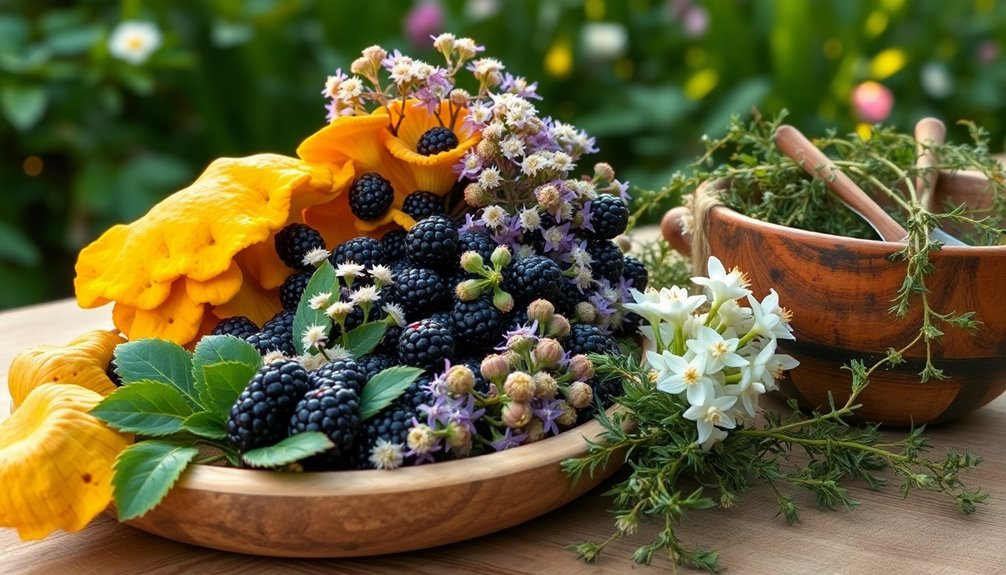
A treasure trove of culinary possibilities awaits in the foraged finds of August. Imagine transforming fresh ingredients into delightful dishes that highlight the season's bounty. Here are some delicious ideas to inspire you:
- Blackberry pies and crumbles: These juicy gems add a burst of flavor to sweet desserts.
- Elderberry wines and cordials: A flavorful treat that's perfect for toasting with friends.
- Crab apple jellies: Their natural pectin makes them ideal for jams that can elevate your breakfast table.
- Hazelnut nut butter: A creamy, nutty spread that's perfect on toast or in baking.
When you pick blackberries, wait until they're deep purple-black for the sweetest taste. You can use them in jams or bake them into crumbles for a comforting dessert.
Elderberries also shine in the kitchen, turning into delightful cordials or jams, but remember to cook them first.
Don't forget about the versatility of hazelnuts, which you can enjoy raw or roasted. Additionally, consider incorporating chia seeds, which can enhance the nutritional value of your foraged dishes. With these foraged finds, your culinary creations will impress everyone at the table!
Safety Tips for Foraging
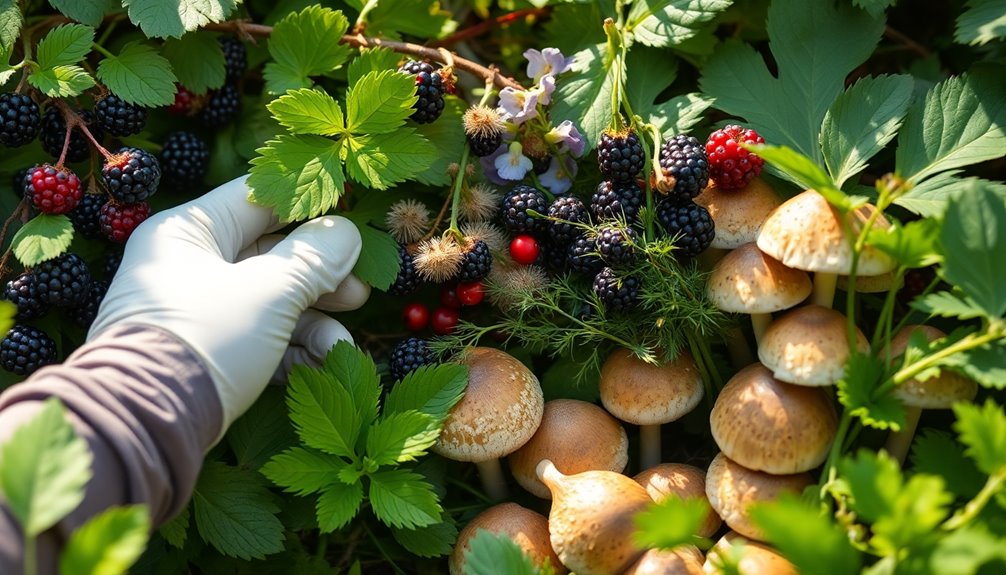
When foraging, it's essential you identify edible species accurately to avoid toxic look-alikes.
Always err on the side of caution and only collect plants you're 100% sure about.
Identify Edible Species
Foraging enthusiasts must be vigilant when identifying edible species to confirm safety and enjoyment in their harvests. Misidentification can lead to serious health risks, so always cross-reference with reliable field guides or resources.
Here are some essential tips to help you identify edible species:
- Pay attention to seasonal indicators; harvest times can vary by region.
- Verify berries are fully ripe before picking; for instance, blackberries should be deep purple-black.
- Cook elderberries before consumption, as they can be toxic when raw.
- Avoid foraging in polluted areas to prevent consuming contaminated plants.
When you're out foraging, be cautious of species that may resemble edible plants. For example, toxic hemlock can easily be confused with edible umbellifers like wild carrot.
Thorough knowledge of the plants in your area is vital to verify you're safely harvesting edible species. By taking these safety tips into account, you can confidently enjoy the delicious rewards of foraging.
Avoid Toxic Look-Alikes
Many foragers face the challenge of distinguishing between edible plants and their toxic look-alikes, a mistake that can lead to serious health issues. To guarantee your foraging in August is safe, always carry a reliable field guide. Familiarize yourself with the visual characteristics of poisonous plants, like the white flowers of Hemlock, which can be easily confused with safe alternatives. Additionally, knowing how to identify toxic plants can significantly reduce the risk of accidental ingestion. Using essential oils, such as eucalyptus oil, may help alleviate respiratory issues that arise from outdoor foraging activities, but it's essential to understand essential oil safety to avoid any adverse reactions. Importantly, some plants may also pose risks to pets, making it vital to consider pet toxicity when foraging in shared environments.
Here's a quick reference table to help you identify some common toxic look-alikes:
| Edible Plant | Toxic Look-Alike | Key Identification Features |
|---|---|---|
| Common Hogweed | Giant Hogweed | Giant Hogweed has larger leaves and can cause severe skin reactions. |
| Wild Carrot | Poison Hemlock | Hemlock has a smooth stem with purple spots and grows in wetter areas. |
| Elderflower | Poisonous Elderberry | Elderflower has small white clusters, while poisonous berries are dark and toxic. |
| Wood Sorrel | Yellow Sorrel | Yellow Sorrel has yellow flowers and is toxic, whereas Wood Sorrel has heart-shaped leaves. |
Participating in local foraging workshops can also enhance your ability to recognize harmful species. Always practice the "one bite" rule to guarantee safety before consuming any new plant. Additionally, understanding the importance of financial planning for assisted living can provide peace of mind as you explore the outdoors.
Forage Responsibly and Sustainably
Responsible foraging means putting safety and sustainability at the forefront of your activities.
To guarantee a responsible experience, here are some key tips to follow:
- Always confirm the identity of foraged plants to avoid toxic look-alikes.
- Harvest only sustainable amounts to protect local wildlife and promote healthy ecosystems.
- Be cautious of foraging in potentially contaminated areas, such as roadsides or urban settings.
- Respect local regulations and private properties, seeking permission where necessary.
When foraging, particularly for mushrooms, it's essential to know your species well.
Many edible varieties have poisonous counterparts that can pose serious health risks.
Utilize reliable guides or consult experienced foragers to help you identify what's safe to eat.
Family-Friendly Foraging Activities

Family foraging adventures can be a fantastic way to bond with your kids while exploring the great outdoors. In August, you can head out to local hedgerows and woodlands to find seasonal berries like blackberries and elderberries. These delicious treats can be eaten raw or cooked, making them perfect for any family meal.
To make your foraging trips even more engaging, download fun foraging log sheets. These free resources allow your kids to document their finds and experiences, enhancing their connection to nature.
You can also incorporate "How To" guides filled with foraging-themed activities, helping children learn about edible plants and their uses.
Consider creating a scavenger hunt during your outings, challenging your kids to find specific plants or berries. This activity not only boosts their observational skills but also adds excitement to the adventure.
Finally, encourage your family to share your foraging discoveries on social media. This fosters community engagement and allows you to exchange knowledge about safe and sustainable foraging practices with others. Additionally, engaging in these activities can help children develop emotional expression as they share their experiences and feelings about nature.
Community Resources and Engagement
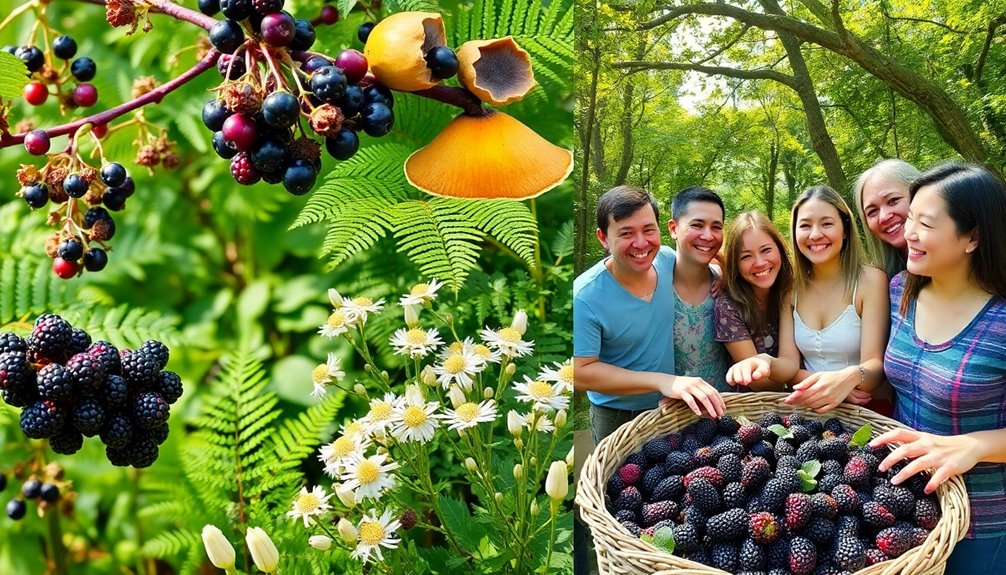
Engaging with your community can greatly enhance your foraging experience. By connecting with fellow foragers, you'll not only share your discoveries but also learn from others. Here are some ways to deepen your community engagement:
- Join local foraging groups on social media
- Share your foraging log sheets to document your finds
- Participate in workshops or guided foraging walks
- Exchange tips and recipes with fellow foragers
Resources like foraging log sheets and "How To" guides are readily available, making it easy for families to educate their children about foraging. Sites like Wild Food UK provide extensive guides on mushroom and hedgerow foraging, catering to both beginners and experienced foragers. Engaging in community events can also promote literacy and educational development, helping families learn about foraging together.
Documenting your finds isn't just for personal growth; it enhances community learning and fosters connections. When you share your experiences online, you encourage others to do the same, building a strong sense of camaraderie.
Frequently Asked Questions
What Can I Forage in August in the UK?
In August, you can forage a variety of delicious treats in the UK.
Look for ripe blackberries, which you'll find deep purple-black, perfect for pies or jams.
Don't miss out on crab apples, bursting with flavor and high in pectin for jellies.
Elderberries offer clusters ideal for cordials, but remember to cook them first.
You might also spot hazelnuts for snacking and lesser-known bilberries that make a tasty treat.
Happy foraging!
What Can You Forage in Autumn in the UK?
Did you know that foraging can save you up to £200 a year?
In autumn, you can find a bounty of goodies in the UK. Look for ripe crab apples, perfect for jellies, and elderberries, great for cordials.
Hazelnuts are ready for roasting, while blackberries still linger for crumbles.
Don't forget about sloes; they're fantastic for making sloe gin. Each find adds unique flavors to your kitchen creations!
When to Pick Bullace in the UK?
You should pick bullace from late August to early September in the UK.
Look for the fruit when it's turned a deep purple or yellowish color, indicating ripeness. It's best to forage during dry weather, as wet fruit can bruise easily.
Be sure to collect from trees that haven't been treated with pesticides.
With their tart flavor, bullace can be great for making jams, jellies, and even wines.
Enjoy your foraging!
What to Avoid When Foraging?
When foraging, you need to be cautious. Avoid umbellifers, as some, like Hemlock, are deadly. Always confirm plant identities to prevent misidentification, which can lead to poisoning.
Steer clear of polluted areas; plants near roadsides might absorb harmful contaminants. If you're foraging for mushrooms, verify you know what you're picking, as many edible types have poisonous look-alikes.
Finally, don't pick unripe or moldy berries, as they can cause digestive issues.
Conclusion
As you explore the rich bounty of August foraging in the UK, remember that nearly 90% of wild plant species are edible! By seeking out delicious berries, unique plants, and coastal treasures, you're not just connecting with nature—you're also enriching your meals. So grab your basket and enjoy the thrill of discovery. With safety in mind, foraging can be a fun, family-friendly adventure that deepens your appreciation for the natural world right in your backyard!


